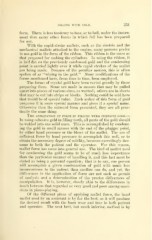Page 529 - My FlipBook
P. 529
FILLING WITH GOLD. 251
form. There is less tendency to tear, or to ball, under the instru-
ment than many other forms in which foil has been prepared
for use.
With the rapid-stroke mallets, such as the electric and the
mechanical mallets attached to the engine, many persons prefer
to use gold in the form of the ribbon. This ribbon is the same as
that prepared for making the cylinders. In using the ribbon, it
is laid flat on the previously condensed gold and the condensing
point is carried lightly over it while rapid strokes of the mallet
are being made. Because of the peculiar motion, this is often
spoken of as "wiping in the gold." Many modifications of the
forms mentioned have, from time to time, been employed.
The forms of crystal gold have been varied greatly by those
preparing them. Some are made in masses that may be pulled
apart into pieces of various sizes, as wanted ; others are in sheets
that may be cut into strips or blocks. Nothing could be said here
that would be of special value. Each m.aker of this form of gold
prepares it in some special manner and gives it a special name.
Otherwise than the outward form presented, they are all prac-
tically the same thing.
The application op force in pilling with cohesive gold.—
In using cohesive gold in filling teeth, all parts of the gold should
be welded into one solid mass. This is accomplished by condens-
ing the gold in small masses with the end of the plugger point,
by either hand pressure or the blows of the mallet. The use of
sufficient force by hand pressure to accomplish this well, or to
obtain the necessary degree of solidity, becomes exceedingly tire-
some to both the patient and the operator. For this reason,
mallet force has come into general use. The kind of mallet used
for condensing the gold seems to be of much less importance
than the particular manner of handling it, and this last must be
stated as being a personal equation ; that is to say, one person
will accomplish a given condensation of gold with much less
inconvenience to the patient than another can do, and yet, the
differences in the application of force are not such as permit
of analysis and a determination of the precise differences of
manipulation. It is, however, closely akin to the differences in
touch between that regarded as very good and poor among musi-
cians in piano-playing.
Of the different plans of applying mallet force, the hand
mallet used by an assistant is by far the best, as it will produce
the desired result with the least wear and tear to both patient
and operator. The next best, but much inferior, method is by


